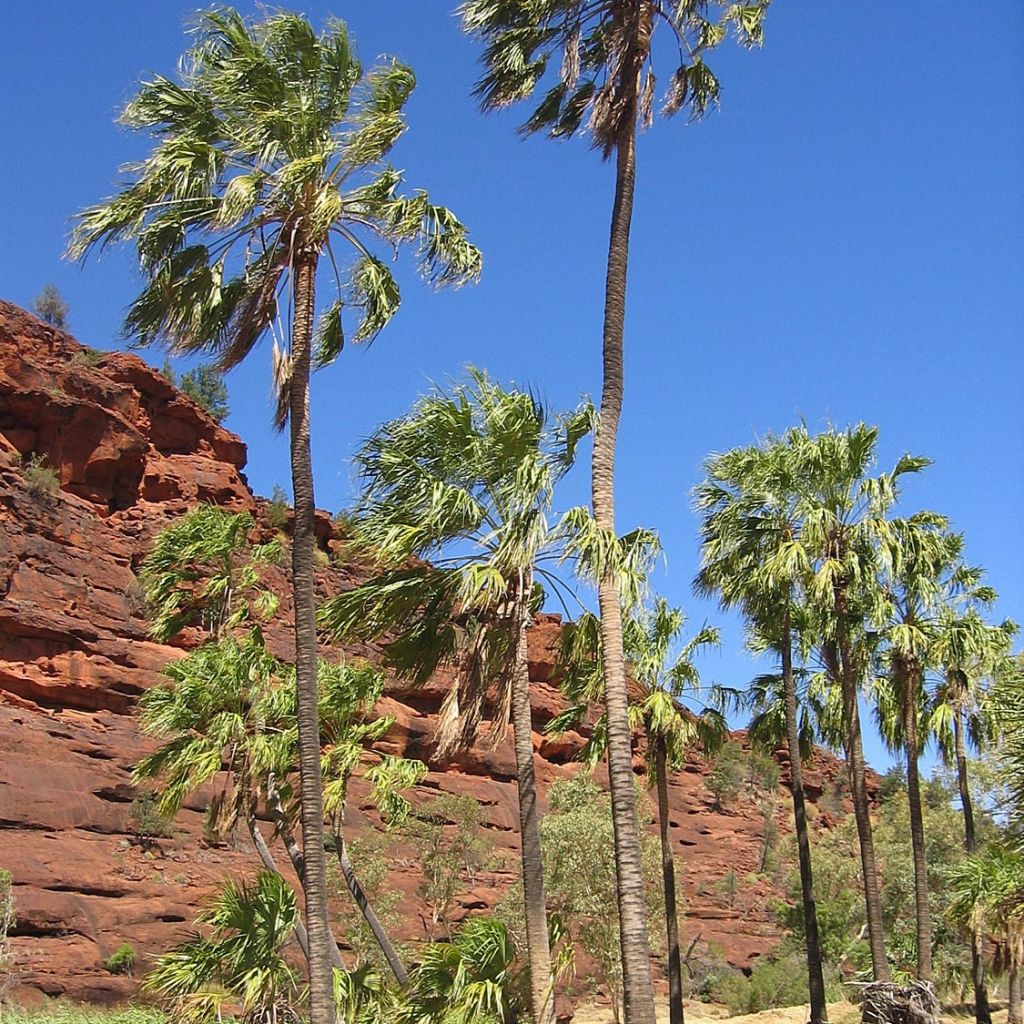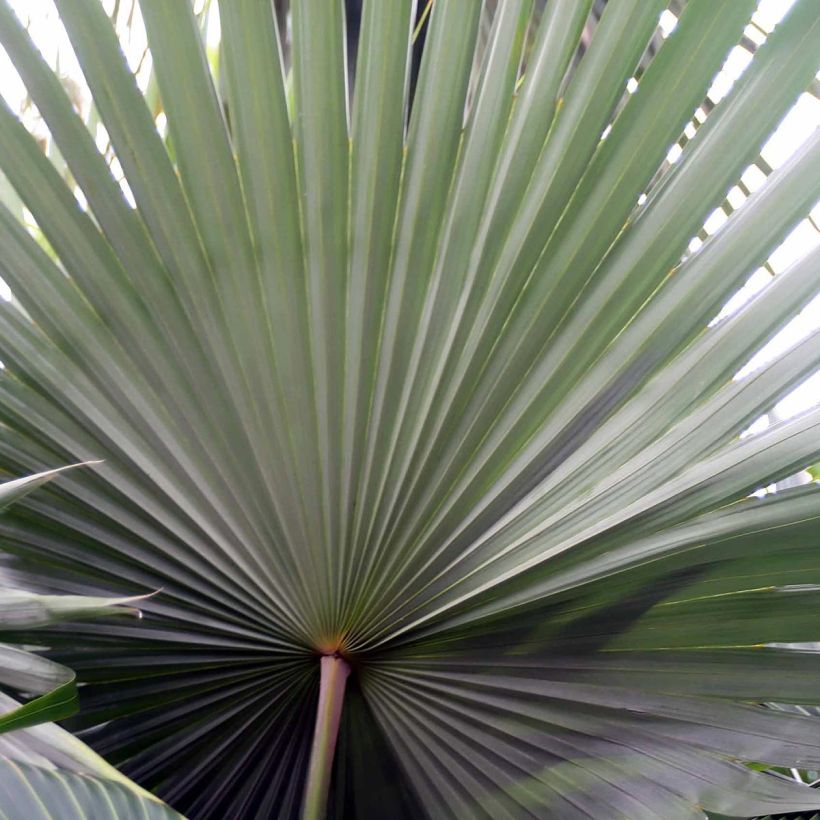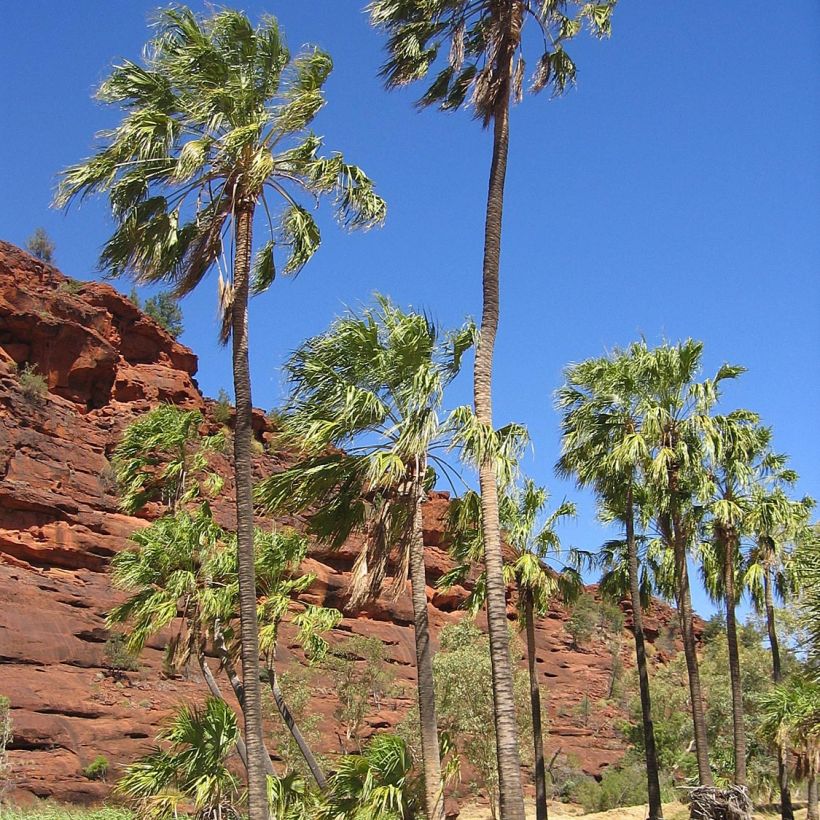

Livistona mariae - Palmier chou d'Australie
Livistona mariae - Central Australian fan Palm
Livistona mariae
Central Australian fan Palm
This plant carries a 24 months recovery warranty
More information
We guarantee the quality of our plants for a full growing cycle, and will replace at our expense any plant that fails to recover under normal climatic and planting conditions.
From €5.90 for pickup delivery and €6.90 for home delivery
Express home delivery from €8.90.
Does this plant fit my garden?
Set up your Plantfit profile →
Description
Livistona mariae, sometimes called the fan palm, stands out from other representatives of the genus Livistona due to its intense reddish colouration, almost metallic, observed only on the foliage of juvenile specimens. This characteristic makes it a highly sought-after indoor plant by collectors who cannot accommodate this rather cold-sensitive species in their garden. An adult specimen, when planted in the ground, is quite impressive: standing on a sturdier trunk than that of other livistona, straight and upright, it bears an elegant crown of slightly trailing fan-shaped leaves, shiny on the top and almost white on the underside. Not demanding in terms of soil, this very beautiful species enjoys sunlight and heat and is resistant to drought once established.
Livistona mariae is native to a very small region located in the centre of the Australian Northern Territory. This old species, probably very ancient, was undoubtedly more widespread at a time when the climate was wetter. It is now confined to a desert area called Palm Valley, where it survives along the dry riverbed. It survives there thanks to the presence of underground water, which its developed root system manages to reach. The cold resistance of an adult plant is estimated at -6°C (21.2 °F) for short periods. In nature, the plant reaches about 20m (65 ft 7 in) in height and 9m (29 ft 6 in) in width. In climates, which are mild enough to accommodate it in the ground, it will have more modest dimensions, around 15m (49 ft 2 in) in height. If grown in a container, it will hardly develop a trunk and will probably not exceed 2m (6 ft 7 in) in height and 1.50m (4 ft 11 in) in width. Like all palms, this Livistona belongs to the family of Arecaceae.
Livistona mariae exhibits slow growth, slightly faster in moist soil. It develops a single trunk, dilated at the base, greyish, vertically fissured, covered with rings that are leaf scars and, in its basal part, with remnants of old petioles. The base of the petioles gradually transforms into a kind of coarse cream-coloured felting that surrounds the trunk. At the tip of this trunk, a fan-shaped crown composed of palmate leaves develops. They are almost circular, slightly wavy, and measure 1.50m (4 ft 11 in) to 2.50m (8 ft 2 in) in diameter. They are glossy grey-green on the top, and the underside is coated with a waxy film that gives them a very light hue. Each leaf is divided at its tip into 50 to 80 thin and rigid segments, which are further divided into two more or less trailing sub-segments at their tip. The long petiole that connects the leaf lamina to the trunk is arched or erect, measuring 1.5m (4 ft 11 in) to 2.20m (7 ft 2 in) in length, and yellowish-green. The lower half of each petiole is equipped with reddish-brown spines. Flowering occurs in summer, on mature subjects and in favourable climates. It takes the form of long highly branched inflorescences that arise between the leaves. They measure 1 to 2m (3 ft 4 in to 6 ft 7 in) in length and are cream-white to yellow. After pollination, rounded fruits form, measuring 1.2 to 1.6cm (0.5 to 0.6 in) in diameter, which change from green to red and then black when ripe. Each fruit contains only one round seed.
This palm tree can only be planted in the ground in sunny and warm gardens sheltered from the wind, in the most sheltered areas. It deserves a prominent place, isolated on a lawn, or in front of a large shrub group that will protect it from the wind. When planted in a large pot or container, it forms a superb green plant, with a striking red colour when young, which will uniquely adorn the terrace or balcony during the summer, and then the conservatory or heated greenhouse in winter. It is sometimes difficult to associate, due to its strong personality: reserve for it a corner of a swimming pool and associate it, for example, with Fargesia bamboos, sculptural, and colorful Phormiums, Cordylines, and Hakonechloa macra Aureola, an easy-to-maintain ground cover with a beautiful orange colour in autumn.
Report an error about the product description
Livistona mariae - Central Australian fan Palm in pictures




Plant habit
Flowering
Foliage
Botanical data
Livistona
mariae
Arecaceae
Central Australian fan Palm
Australia
Planting and care
Livistona mariae dislikes the cold, especially young plants that will need to be protected from frost in winter in a veranda or greenhouse. Adult plants can withstand brief freezes of around -6°C (21.2 °F), but the foliage will burn at -4°C (24.8 °F). Choose a very sunny exposure, sheltered from cold and dry winds. It can only be grown in the ground in very sheltered gardens, plant in a large pot to be overwintered in other regions. It should be protected in case of expected cold weather by tying the crown of leaves tightly enough to protect the heart of the plant. Young plants appreciate partial shade, while older plants tolerate full sun. This palm is not demanding in terms of soil, as long as it is deep, well-prepared, and well-loosened. While it appreciates moist soil, it can withstand summer drought once it is well established. Any well-drained soil without excess limestone will suit it. It requires little maintenance other than pruning the oldest fronds close to the stem.
Cultivation in a pot:
Choose a very large pot or container with a perforated bottom and a capacity of 75 to 100 litres. Prepare a mixture consisting of 50% loam, 25% compost, and 25% sand. Mix well. Fill your container partially, after placing a drainage layer at the bottom (clay balls, gravel, broken terracotta pots...). Place your palm on the mixture, making sure that the neck (the area where the roots originate) does not exceed the pot but is not buried too deep in the substrate either. Add the rest of the mixture around the rootball, firming it down. Water in several stages to thoroughly saturate the substrate and eliminate air pockets. Place your palm in a very bright location, avoiding direct sunlight. When outdoors, place it in partial shade, avoiding full sun that could scorch its foliage. After two weeks in partial shade, you can gradually expose it to the sun. In winter, it can be placed in an unheated room, in diffused light, in a temperate greenhouse, or in a veranda. Spray the foliage from time to time and reduce watering. Apply organic fertilizer or compost in spring.
Diseases and pests:
In some areas large palm trees are affected by parasites such as the larvae of the dreaded and widespread Paysandra archon, a large butterfly that is active even in England. Specific treatments are now available as a preventive measure. The red palm weevil (Rhynchophorus ferrugineus) has been present since 2006. The symptoms are as follows: fronds that are cut, dried, or yellowing. These pests attack numerous palm species, with a fatal outcome: the leaves irreversibly and completely dry out as soon as the heart of the stem houses larvae.
Planting period
Intended location
Care
This item has not been reviewed yet - be the first to leave a review about it.
Haven't found what you were looking for?
Hardiness is the lowest winter temperature a plant can endure without suffering serious damage or even dying. However, hardiness is affected by location (a sheltered area, such as a patio), protection (winter cover) and soil type (hardiness is improved by well-drained soil).

Photo Sharing Terms & Conditions
In order to encourage gardeners to interact and share their experiences, Promesse de fleurs offers various media enabling content to be uploaded onto its Site - in particular via the ‘Photo sharing’ module.
The User agrees to refrain from:
- Posting any content that is illegal, prejudicial, insulting, racist, inciteful to hatred, revisionist, contrary to public decency, that infringes on privacy or on the privacy rights of third parties, in particular the publicity rights of persons and goods, intellectual property rights, or the right to privacy.
- Submitting content on behalf of a third party;
- Impersonate the identity of a third party and/or publish any personal information about a third party;
In general, the User undertakes to refrain from any unethical behaviour.
All Content (in particular text, comments, files, images, photos, videos, creative works, etc.), which may be subject to property or intellectual property rights, image or other private rights, shall remain the property of the User, subject to the limited rights granted by the terms of the licence granted by Promesse de fleurs as stated below. Users are at liberty to publish or not to publish such Content on the Site, notably via the ‘Photo Sharing’ facility, and accept that this Content shall be made public and freely accessible, notably on the Internet.
Users further acknowledge, undertake to have ,and guarantee that they hold all necessary rights and permissions to publish such material on the Site, in particular with regard to the legislation in force pertaining to any privacy, property, intellectual property, image, or contractual rights, or rights of any other nature. By publishing such Content on the Site, Users acknowledge accepting full liability as publishers of the Content within the meaning of the law, and grant Promesse de fleurs, free of charge, an inclusive, worldwide licence for the said Content for the entire duration of its publication, including all reproduction, representation, up/downloading, displaying, performing, transmission, and storage rights.
Users also grant permission for their name to be linked to the Content and accept that this link may not always be made available.
By engaging in posting material, Users consent to their Content becoming automatically accessible on the Internet, in particular on other sites and/or blogs and/or web pages of the Promesse de fleurs site, including in particular social pages and the Promesse de fleurs catalogue.
Users may secure the removal of entrusted content free of charge by issuing a simple request via our contact form.
The flowering period indicated on our website applies to countries and regions located in USDA zone 8 (France, the United Kingdom, Ireland, the Netherlands, etc.)
It will vary according to where you live:
- In zones 9 to 10 (Italy, Spain, Greece, etc.), flowering will occur about 2 to 4 weeks earlier.
- In zones 6 to 7 (Germany, Poland, Slovenia, and lower mountainous regions), flowering will be delayed by 2 to 3 weeks.
- In zone 5 (Central Europe, Scandinavia), blooming will be delayed by 3 to 5 weeks.
In temperate climates, pruning of spring-flowering shrubs (forsythia, spireas, etc.) should be done just after flowering.
Pruning of summer-flowering shrubs (Indian Lilac, Perovskia, etc.) can be done in winter or spring.
In cold regions as well as with frost-sensitive plants, avoid pruning too early when severe frosts may still occur.
The planting period indicated on our website applies to countries and regions located in USDA zone 8 (France, United Kingdom, Ireland, Netherlands).
It will vary according to where you live:
- In Mediterranean zones (Marseille, Madrid, Milan, etc.), autumn and winter are the best planting periods.
- In continental zones (Strasbourg, Munich, Vienna, etc.), delay planting by 2 to 3 weeks in spring and bring it forward by 2 to 4 weeks in autumn.
- In mountainous regions (the Alps, Pyrenees, Carpathians, etc.), it is best to plant in late spring (May-June) or late summer (August-September).
The harvesting period indicated on our website applies to countries and regions in USDA zone 8 (France, England, Ireland, the Netherlands).
In colder areas (Scandinavia, Poland, Austria...) fruit and vegetable harvests are likely to be delayed by 3-4 weeks.
In warmer areas (Italy, Spain, Greece, etc.), harvesting will probably take place earlier, depending on weather conditions.
The sowing periods indicated on our website apply to countries and regions within USDA Zone 8 (France, UK, Ireland, Netherlands).
In colder areas (Scandinavia, Poland, Austria...), delay any outdoor sowing by 3-4 weeks, or sow under glass.
In warmer climes (Italy, Spain, Greece, etc.), bring outdoor sowing forward by a few weeks.


































